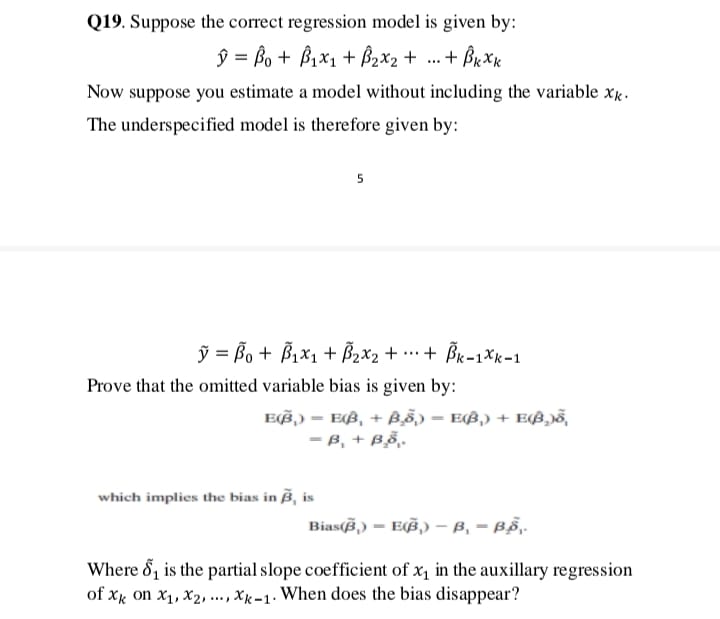Home /
Expert Answers /
Statistics and Probability /
q19-suppose-the-correct-regression-model-is-given-by-hat-y-hat-beta-0-hat-beta-1-x-1-pa169
(Solved): Q19. Suppose the correct regression model is given by: hat(y)=hat(\beta )_(0)+hat(\beta )_(1)x_(1)+ ...
Q19. Suppose the correct regression model is given by:
hat(y)=hat(\beta )_(0)+hat(\beta )_(1)x_(1)+hat(\beta )_(2)x_(2)+dots+hat(\beta )_(k)x_(k)
Now suppose you estimate a model without including the variable x_(k).
The underspecified model is therefore given by:
tilde(y)=tilde(\beta )_(0)+tilde(\beta )_(1)x_(1)+tilde(\beta )_(2)x_(2)+cdots+tilde(\beta )_(k-1)x_(k-1)
Prove that the omitted variable bias is given by:
E(widetilde(\beta )_(1))=E(hat(\beta )_(1)+hat(\beta )_(2)tilde(\delta )_(1))=E(hat(\beta )_(1))+E(hat(\beta )_(2))tilde(\delta )_(1)
=\beta _(1)+\beta _(2)tilde(\delta )_(1).
which implies the bias in widetilde(\beta )_(1) is
Bias(widetilde(\beta )_(1))=E(widetilde(\beta )_(1))-\beta _(1)=\beta _(2)tilde(\Phi )_(1).Q19. Suppose the correct regression model is given by:
hat(y)=hat(\beta )_(0)+hat(\beta )_(1)x_(1)+hat(\beta )_(2)x_(2)+dots+hat(\beta )_(k)x_(k)
Now suppose you estimate a model without including the variable x_(k).
The underspecified model is therefore given by:
tilde(y)=tilde(\beta )_(0)+tilde(\beta )_(1)x_(1)+tilde(\beta )_(2)x_(2)+cdots+tilde(\beta )_(k-1)x_(k-1)
Prove that the omitted variable bias is given by:
E(tilde(\beta )_(1))=E(\beta _(1)+\beta _(2)tilde(\delta )_(1))=E(hat(\beta )_(1))+E(\beta _(2))tilde(\delta )_(1)
=\beta _(1)+\beta _(2)tilde(\delta )_(1).
which implies the bias in widetilde(\beta )_(, ) is
Bias(tilde(\beta )_(1))=E(tilde(\beta )_(1))-\beta _(1)-\beta _(1)tilde(\Phi )_(1).
Where tilde(\delta )_(1) is the partial slope coefficient of x_(1) in the auxillary regression
of x_(k) on x_(1),x_(2),dots,x_(k-1). When does the bias disappear?